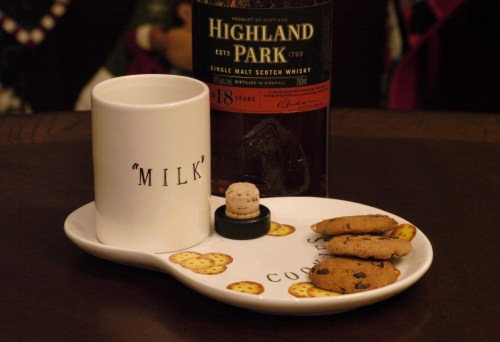Introduction
 Big thanks to the folks at Deep Focus, a social media agency working with The Glenlivet, for sending me a free sample of the new Glenlivet Alpha expression that has only 3350 bottles shipping worldwide (not sure how many are coming to the U.S.). Especially since I’ve been flying under the whisky radar this past year (I’ll post more on that later). I haven’t checked out all of the marketing details, but apparently there is going to be a big “reveal” for Alpha in a few days, so I thought I’d go ahead and post some thoughts on the whisky while it is still something of a mystery (the box only states that it is a Single Malt bottled at 50% abv). The U.S. retail price is $120.
Big thanks to the folks at Deep Focus, a social media agency working with The Glenlivet, for sending me a free sample of the new Glenlivet Alpha expression that has only 3350 bottles shipping worldwide (not sure how many are coming to the U.S.). Especially since I’ve been flying under the whisky radar this past year (I’ll post more on that later). I haven’t checked out all of the marketing details, but apparently there is going to be a big “reveal” for Alpha in a few days, so I thought I’d go ahead and post some thoughts on the whisky while it is still something of a mystery (the box only states that it is a Single Malt bottled at 50% abv). The U.S. retail price is $120.
Tasting Notes
On the nose, my first impression is of cinnamon apples. Then vanilla custard, and finally some fresh wood shavings. Then back to the fruit, of the apples and pears variety. Looking online now at other reviews, I see people talking about lots of tropical fruits. Personally, that’s not the way I respond to this. It doesn’t strike me as tropical in the same way as something like Glenmorangie 18 year. But of course, this is all subjective.
On the palette, it starts out mouth-watering and juicy, sweet, then very slightly prickly on the tongue. There is a point where it becomes slightly nutty, and just as I start to expect a slight walnut bitterness, it pulls back. Very nice. It’s smooth as silk…almost buttery going down. It then becomes drying on the finish, before my mouth waters up again. A very enjoyable, if not particularly long, experience.
Update: On finishing my sample last night, I felt like there was some citrus included in the ample fruitiness. Primarily on the palate and finish. I Still don’t get pineapples or coconut. That doesn’t mean I think everybody else is crazy. Just some insight into my own taste interpretation.
Impression
The Glenlivet Alpha is an extremely drinkable expression that would be great for sharing with all levels of whisky drinkers. It strikes me as a Special Edition release of their Nadurra expression. The overall flavor profile (especially on the nose) is quite similar. However, the Alpha has an extra silky smoothness to it relative to Nadurra, in the same way the 17 year finished Balvenie expressions relate to the 15 year single barrel. Though, I don’t detect anything resembling the typical “finishing” casks of sherry or wine in Alpha.
So what is it?
If this is a game, and we’re supposed to guess what the heck is in this black Alpha bottle, I’d have to guess a combination of first-fill and second-fill American White Oak bourbon barrels were used to mature the spirit. There is no sign of coloring or chill filtration (like Nadurra). Age? That’s a hard one. Is the extra buttery smoothness in the mouth over the Nadurra due to age, or is it related to the type of casks used? Not sure. I could believe a number of scenarios: 1) It’s a year or two older than the 16 year Nadurra. 2) They use a combination of refill casks and smaller quarter casks to give the impression of extra maturity, while keeping the oak in check, or 3) this is just the result of very carefully selected casks by the master distiller.
Value
Did I really enjoy this whisky? Yes. Am I going to seek out a bottle? No. Do I think you’re an idiot if you do? No.
I really like this whisky, but for me, the 16 year Nadurra (at $50/bottle locally) is close enough in profile to keep me satisfied. On the other hand, I have no immediate issues with the price of Alpha. They are saying that it was “carefully crafted” by the master distiller, and it is a limited release of 3,350 bottles. It’s not going to be for everybody, but then, the limited run kind of takes care of that. 🙂
I’ve seen much higher prices asked for “carefully selected” expressions…how about the Diageo Manager’s Choice a few years ago? Talk about crazy pricing. These things work themselves out, though. A bunch of those Manager’s Choice bottles can still be had at 40% discounts online. So far, The Glenlivet Alpha is selling out quickly. The UK allocation disappeared immediately. If, upon commencing with their “reveal” on Facebook later this week, people are outraged by what they hear, then I’d expect that feedback to influence future releases.
If they keep their main line whiskies priced reasonably, and of high quality, what’s the harm in experimenting with various boutique releases aimed at smaller segments of the market? I look forward to learning more about the story behind The Glenlivet Alpha.
B+ on my scale
Cheers, Jeff
















